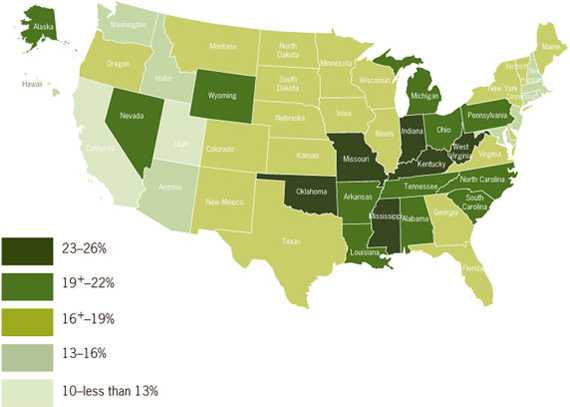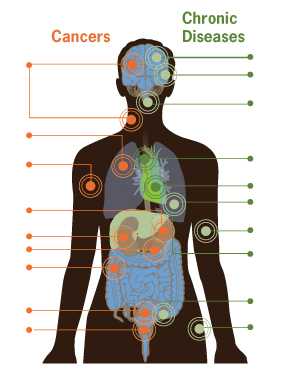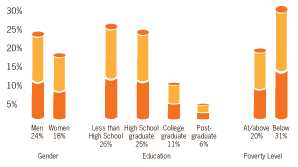Tobacco Use
Smoking & Secondhand Smoke
September 2010


 46.6M
46.6M
About 1 in 5 adults smoke.
 40%
40%
4 out of 10 nonsmokers(88 million people) are exposed to secondhand smoke.
 54%
54%
More than 1 out of 2 kids(aged 3–11 years) are exposed to secondhand smoke.
Tobacco use is the leading preventable cause of death, disease, and disability in the US. Each year, around 443,000 people die from smoking or exposure to secondhand smoke, and another 8.6 million suffer from a serious illness from smoking. Two new CDC reports indicate that, despite the dangers of tobacco use, about 46.6 million adults in the US smoke, and 88 million nonsmokers are exposed to secondhand smoke.
Problem
Millions of people in the US still smoke
The decline in smoking has stalled in the past five years.
- In 2005, about 20.9% of adults smoked cigarettes. In 2009 about 20.6% smoked.
Some groups smoke more.
- More men (nearly 24%) than women (about 18%) smoke.
- Nearly 30% of multiracial adults and 23% of American Indian/Alaska Native adults smoke.
- Smoking rates are higher among people with a lower education level. For example, nearly 1 in 2 of all US adults who have a GED smoke; only around 6% of people with a graduate degree smoke.
- About 31% of people who live below the poverty level smoke.
Although the number of teenagers in the US who smoke continues to drop year after year, progress is slowing.
- In 1997, about 36% of high school students smoked cigarettes.
- Between 1997–2003, the rates of smoking among high school students dropped from 36% to about 22%. However, between 2003 to 2009, declines slowed from 22% to 20%. The slowing decline in teen cigarette use suggests that smoking and all the health problems related to smoking will continue as teens become adults.
- In 2009, nearly 1 in 5 high school students (20%) still smoked cigarettes. Monitoring teen smoking is important because most adult smokers (about 80%) began smoking before the age of 18.
States and regions in the US have different smoking rates.
- Utah has the lowest smoking rate; fewer than 10% of adults in Utah smoke cigarettes.
- Kentucky and West Virginia have the highest smoking rates; nearly 26% of adults smoke in both states.
- Fewer people smoke in the West (about 16%), and more people smoke in the Southeast (about 22%) and Midwest (about 23%).
Risks from Smoking
U.S. State Info
Adult smoking rates vary across the US, but the states with the most smokers are in the Midwest and Southeast regions.

What Can Be Done
Smokers and smokeless tobacco users can:
- Quit. Ask your doctor for help in making a plan to quit or call 1-800-QUIT-NOW (800-784-8669; TTY 800-332-8615).
- Never smoke in your home, vehicles, or around nonsmokers, especially children, pregnant women, and persons with heart disease or respiratory conditions.
Parents and nonsmokers can:
- Quit if you smoke. Children of parents who smoke are twice as likely to become smokers.
- If you can't stop yet, never smoke or allow others to smoke in your home, vehicles, or around your children.
- Teach your children about the health risks of smoking and secondhand smoke.
- Not start, if you aren't already using tobacco.
Employers can:
- Establish a policy banning the use of any tobacco product indoors or outdoors on company property by anyone at any time.
- Provide all employees and their dependents with health insurance that covers support for quitting without copayment.
Retailers can:
- Learn the new FDA restrictions on youth access to tobacco products and tobacco marketing to youth, and closely follow them.
- Check the photo ID of any customer trying to buy tobacco products who appears to be 26 years of age or younger, and never sell any tobacco product to customers younger than 18 years of age.
Doctors, nurses, and other health care providers can:
- Ask all patients and parents of pediatric patients whether they use tobacco, and advise those who do to quit.
- Advise everybody to make their homes and vehicles 100% smoke-free 24/7.
- Advise nonsmokers to avoid being exposed to secondhand smoke, especially if they are pregnant or have heart disease or respiratory conditions.
State and community leaders can:
- Consider the World Health Organization's MPOWER strategies in efforts to prevent and control tobacco use.
Monitor tobacco use and prevention policies
Protect people from tobacco smoke
Offer help to quit
Warn about the dangers of tobacco use
Enforce bans on tobacco advertising
Raise taxes on tobacco - Establish comprehensive tobacco control programs funded at CDC-recommended levels and sustain them over time.
- Reduce tobacco use by making tobacco products less accessible, affordable, desirable, and accepted.
Science Behind the Issue
- Page last reviewed: September 7, 2010
- Page last updated: October 29, 2013
- Content source:
- National Center for Chronic Disease Prevention and Health Promotion,
Office of Smoking and Health - Page maintained by: Office of the Associate Director for Communications (OADC)
- National Center for Chronic Disease Prevention and Health Promotion,


 ShareCompartir
ShareCompartir

